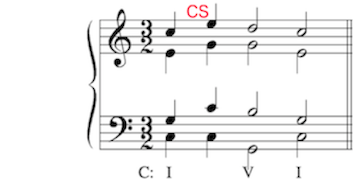
HARMONIC EXPANSIONS
CHAPTER 1: EXPANDING THE TONIC TRIAD; THE FUNDAMENTAL HARMONIC PROGRESSION
1.6 Expanding the initial tonic with consonant skips
 |
 |
 |
 Haydn's "Miracle" Symphony (No. 96) is one of his "London" Symphonies, written for a London audience. The above painting is a view of London at the time by Antonio Canaletto. |
Haydn: Third movement of the "Miracle" Symphony with a consonant skip and a more distant lower neighbor  |
In the third movement of his "Miracle" Symphony Haydn wrote a melody which begins A, D and F-sharp, all members of the tonic triad, D Major. In this way he expanded the initial tonic triad by adding more chord tones to the melody.
|
So each chord of the fundamental harmonic progression can itself be expanded. See the illustration to the right which demonstrates these consonant skips (CS) in four voices. A consonant skip is a chord tone which is approached by skip from another chord tone. To expand the initial tonic with consonant skips, insert another tonic chord, with soprano changing from scale degree 1 to 3, or 3 to 1, before the dominant. Spacing may change between tonic chords. Choose open or close, whatever is smoother. |

|
|
Expansions of the tonic can also be made with other embellishing tones. See for instance the example to the left in which the initial tonic in the fundamental harmonic progression from page 1.4 is expanded with lower neighbors. More detail in Chapter 2. | |
| More Distant Embellishing Tones As phrases get longer, embellishing tones can have more distant relationships. Play the video to the right.
|
|
Your turn! 1. DOWNLOAD pdf file 01.6 to print out and write on. 2. ENTER your part writing on the Harmonic Expansions 1.6 page in Noteflight. |
 |
 |
 |
 |
 |
Comments? Click here. |



